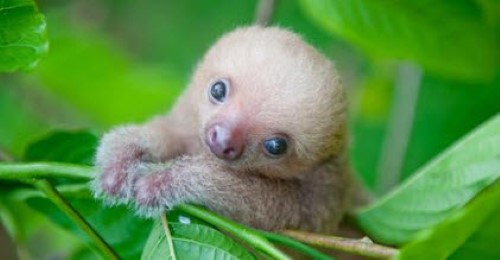Sloths are rather interesting creatures. They are not only cute and cuddly, they are often misunderstood. Sloths spend the majority of their lives in trees and, contrary to popular beliefs, they only sleep about 10 hours a day. The only time a sloth will come down from the tree is to urinate or defecate and they do so at the same spot every time. That leaves them open to predators.
A sloth is perhaps best known for being slow. In fact, they only travel about 2 meters per minute when they are on the ground. They move so slow that algae grows on their fur.
Perhaps the fact we know best about sloths is that they are adorable. Perhaps that is why we have a soft spot for these creatures. When a sloth gets lost at a young age, who steps in to help. The sloth institute is there to lend a hand.
A sloth loves nothing more than climbing trees, but they cling to other sloths as well. It is the way they survive infancy.

Sam Trull, co-founder of The Sloth Institute Costa Rica knows sloths very well.
She has been in Costa Rica since 2013, doing everything in her power to help baby sloths and get them back into the wild safely.

The process of releasing sloths into the wild is a difficult, slow process.
Sloths who spend their young lives in captivity miss out on learning some of their primary survival skills. They typically learn them from their mother. Humans are also still learning much about sloths, and it can be difficult to give them what they need.

Trull is determined to keep working. She knows that the sloths will be happier once they are in the wild. She had this to say:
“I think there is a big misconception that because sloths are slow and lazy they are okay with captivity … but that couldn’t be further from the truth.”
Before she worked with sloths, Trull worked with primates in both the United States and elsewhere. She began helping sloths when she joined a rehabilitation clinic on the Pacific coast in 2013.

It was there that she met a 2 week old baby sloth named Kerimie. He had recently lost his mother.
For Trull, it was love at first sight and took on the role of Kermie’s mother.

She gave Kermie plenty of love, feeding and playing with him. She never lost sight of the ultimate goal of returning him to the jungle. The release was done in a fashion known as a soft release.
The soft release allows the baby sloth time to get acclimated to their new jungle home before they are completely on their own.

In order to make the soft release happen, they set up a 19 foot cage near the release site. It gave them time to make sure the sloth was ready for life in the wild.
Once they were sure the sloth is ready, they open the doors. The sloths can come and go at will but eventually, the goal is for them to be completely in the wild.
Kermie and another sloth, Ellen, were both soft released in 2015.

As of this time, they are both doing fine.
Although they are in the wild, Trull and her team continue to keep their eye on them. Ultimately, there is little they can do to make sure they are safe in the wild.
Trull feels that one of the most difficult parts of her job is letting go. Over the years, there has been a number of sloth casualties and each of them was devastating.

The majority of the deaths took place in captivity, so it only served to strengthen Trull’s resolve to get the others to their home in the wild.

The Sloth Institute works with other rescue and rehabilitation organizations now but they are looking to be more on their own.
This would allow them to have a greater reach but doing so would require funding and research. Unfortunately, those factors keep Trull away from the sloths.
Today, she is no longer hand-raising the sloth babies every day but she stays close by so she can check in on things. When all is said and done, it comes down to sloth love, which happens to be the name of Trull’s new book.

Her book contains many beautiful photos she took on her journey. It speaks about the relationship she formed with the sloths she rescued.
Something Trull gained from the experience is to love absolutely and unconditionally.

They have also taught me to never give up … that the only way to make progress in life is to persevere through each and every obstacle with the knowledge that another one is coming.
Via: Upworthy
Be sure to share this with your friends on Facebook

